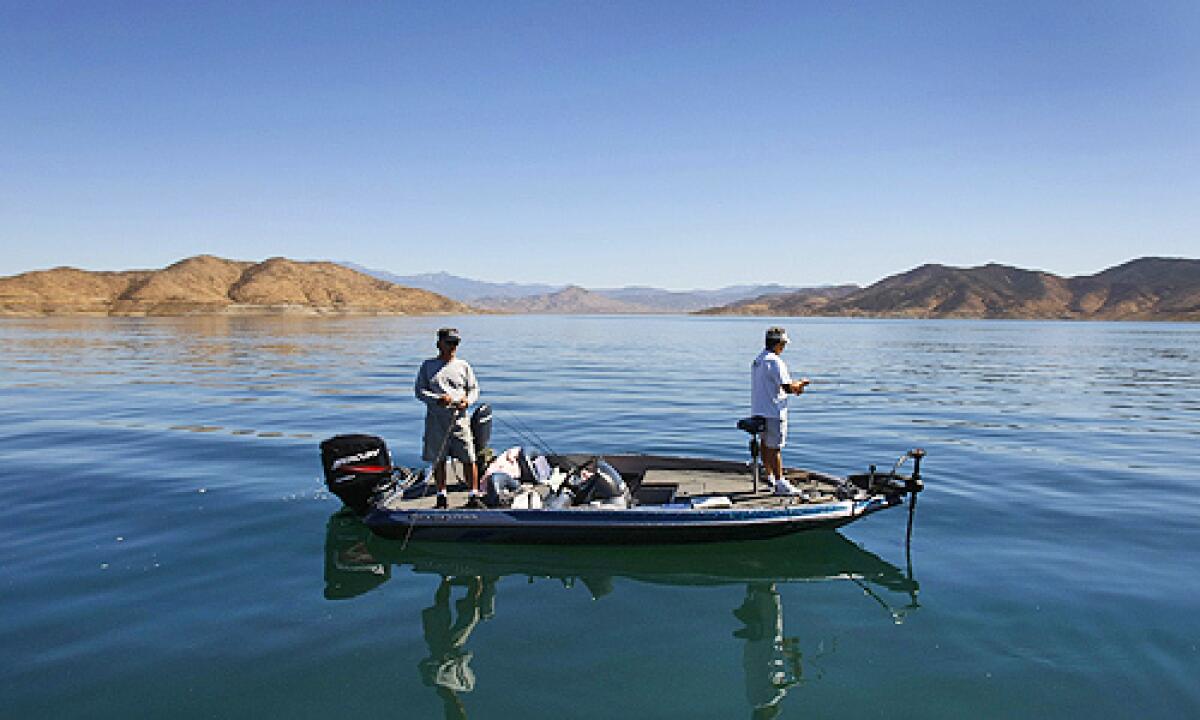As water level drops at Diamond Valley, rationing becomes more likely

- Share via
Diamond Valley Lake, the giant regional reservoir in Riverside County, has been called the “jewel” of Southern California when it comes to pleasure boating and bass fishing.
But the jewel has been tarnished by the water woes gripping Southern California.
The water level in the 4,500-acre lake near Hemet is down by nearly 40%, and on Monday the lake’s owner, the Metropolitan Water District of Southern California, will close the boat ramp.
Anglers have watched for months as the water level has declined, leaving a bathtub-style ring around the 20 miles of shoreline.
“It’s just gotten worse and worse every day,” bass fisherman Clint Sumner, 41, of Escondido said as he eased his 21-foot Ranger into the water this week.
Opened in 2003 at a cost of $2 billion, Diamond Valley was meant to be the major drinking-water storage facility for thirsty Southern California, as well as an insurance policy against a traumatic cutoff of water. It’s the largest reservoir in Southern California.
Now it’s a sign of the twin problems hitting the region: For two years, drought and cutbacks have kept the MWD from diverting any Colorado River water for storage at Diamond Valley; and a judge’s decision designed to save the Delta smelt led to a reduction of water delivered from Northern California.
In June 2006, Diamond Valley Lake was full, with 810,000 acre-feet of water. This week, the figure was at 485,236 and dropping. Once, the deepest spot measured 280 feet, now it’s at 200.
As supply has decreased, water from Diamond Valley has been sent by the MWD to its customers to supplement their own declining allocations. “We’d have been rationing three years ago if we didn’t have Diamond Valley,” said MWD General Manager Jeff Kightlinger.
But the end may be in sight, hastening the day of rationing throughout Southern California. Estimating when Diamond Valley will no longer be able to ship water to local agencies is a mixed issue of hydrology and politics.
Drawing the reservoir down too far could leave the region in dire straits -- much like a person who stops paying his homeowner’s insurance to save money just days before his house is hit by fire.
Diamond Valley was designed as an emergency source of water in the event of an earthquake or other disaster that could cut flows from the Colorado River and Northern California.
Reservoirs throughout the state are in similar predicaments as storage levels drop. Farms, cities and suburbs are all being hit.
In Los Angeles, the mayor has been pleading with residents and businesses to reduce consumption, backed up by a new “drought buster” ordinance.
In Imperial Valley, where farmers long enjoyed virtually unlimited water supplies, a fallowing program is being developed whereby farmers would let a portion of their fields go dry. And in San Diego, the water authority is paying for gloomy television commercials warning of rationing if residents don’t stop lavish watering of lawns and washing of cars.
For bass fishermen, the loss of the boat ramp means cancellation of tournaments and a prowl for new fishing spots. Last year, 13,000 launches were made from the 11-lane ramp at Diamond Valley. With the water receding, the chance of vehicles getting stuck in the mud has increased.
The MWD board will consider extending the ramp farther into the water so that launching can resume. As an engineering feat, it would not be difficult.
But it could cost an estimated $1.7 million at a time when the Wall Street financial meltdown is making money tight even for public agencies with good credit, like the MWD. A problematic issue is whether the needs of bass fishermen should compete with projects enhancing the ability to bring water to customers.
Soon the MWD board will consider plans for rationing. The choices may boil down to two equally unpleasant alternatives: “easing into it” with relatively moderate reductions in 2009 or waiting until 2010 and cutting “steeply,” Kightlinger said.
“Our board will be debating when to pull the trigger on rationing,” he said.
At Diamond Valley, visitors can still rent pontoon boats or rowboats.
Still, fishing enthusiasts say it’s not the same as putting your own craft into the water, speeding to your favorite spot where the fish lurk (near the dams is said to be the best) and then matching wits with the largemouth or striped bass.
Stan Achhammer, 61, of Yucaipa, a retired troubleshooter for a telephone company, figures he’ll try some other local lakes but doubts any will match Diamond Valley.
“I guess I’ll pick up the wife and cats and move to Clear Lake” in Northern California, he said.
More to Read
Sign up for Essential California
The most important California stories and recommendations in your inbox every morning.
You may occasionally receive promotional content from the Los Angeles Times.










